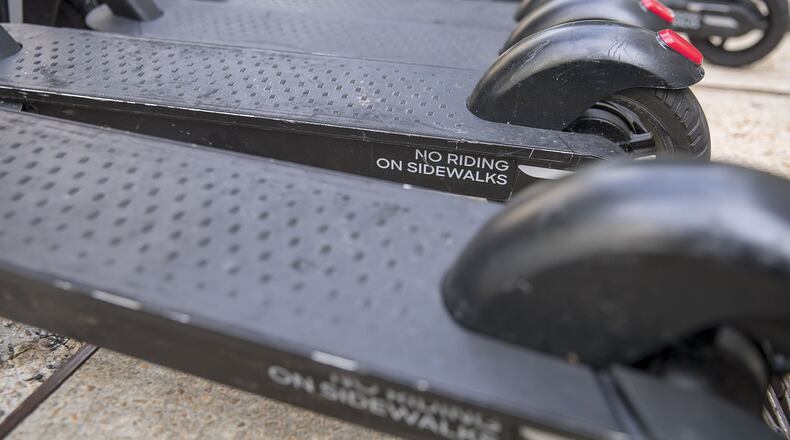Anyone doubting that the future won’t look much like the past need only look at the e-scooter craze.
In less than three years, the electric scooter business has skyrocketed in metro Atlanta and many other places having a critical mass of potential users, especially young people.
As is often the case in our hyper-speed world, technology readily outran efforts to rein in downsides as scooters quickly went viral.
Novelty, and growing popularity, have led to serious public concerns. Four scooter riders have died in accidents so far this year in metro Atlanta. That rightfully got our attention, as it’s believed to be more fatalities than any other city so far. Many other riders have been injured, some seriously, from scooter mishaps, although most trips are made safely.
As the potential risks of scooter-riding become more visible, governments have taken notice and begun efforts to regulate the scooter phenomenon with an eye toward managing risks, even as others worry that a heavy bureaucratic hand will stifle a valuable innovation that can increase mobility.
Making scooter networks safer is a worthwhile goal, we believe. And not out of line with similar societal efforts. Consider the reasonable, but substantial, requirements that must be met for driving more-traditional motor vehicles – passing driving tests, obtaining a license, maintaining liability insurance, etc.
Admittedly, the analogy isn’t perfect, as a 15 mph scooter isn’t an SUV, or even a subcompact auto – and thus doesn’t likely deserve to be weighed down by as much regulation.
That said, there does increasingly seem to be a need for thoughtful regulation and guidance intended to help safeguard riders, pedestrians and motorists.
Many other cities in the U.S., and globally, are working through this same challenge.
There’s a bit of a knowledge vacuum, too, in that scooters are so new that a broad body of data around such things as usage patterns and injuries has not yet been amassed.
Based on what we do know now, here are some commonsense points that governments should consider:
- Given fatal accidents, requiring helmet use by riders seems a sound measure.
- Tracking where and when mishaps occur, in as close to real-time as possible, should prove useful in crafting smart scooter policies.
- Limiting scooter use to certain geographic boundaries might be worth considering, especially if the allowed areas correlate closely with where riders are already showing up in force. City officials might also find it appropriate at some point, for example, to curb scooter use on trails like the popular Beltline.
- Creating scooter "districts," however, might clash with an upside of their growing popularity. They're touted as being low-cost transportation, which could be important for low-income people who often lack cars or other ready access to reliable transportation. Scooters could do an efficient job of getting people to transit stops or even to jobs a short ride away. In that use, managed well here, they could help reduce poverty. Smart public policy should be able to find a balance between geographic limits and unduly limiting access for those who can benefit most.
In considering how best to handle scooters, metro Atlanta’s undersized infrastructure candidly works against us. Our relatively puny network of streets, especially wide ones, hasn’t kept up with our growth, and that leaves precious little room today for dedicated lanes for scooters or other, non-motorized vehicles. In many other places, street grids are laced with broad boulevards, where lanes could be reserved for scooters with relatively minimal effects as compared to metro Atlanta, where two-lane roads often serve as heavy-traffic arterial streets.
Government officials in Atlanta and elsewhere around the region, and GDOT, seem aware of the need to better accommodate vehicles that aren’t automobiles. Catching up with the demand for mobility alternatives will take time, though — and cost money. Remaining a competitive city in the future demands that we don’t skimp on such efforts.
The road ahead on scooters is new for us all. Different tactics will be used to address this phenomenon. Miami, for example, has restricted scooters to a pilot project in a set district. Oakland, California, has been praised for its approach encouraging scooter use beyond affluent areas. Oakland also frowns on sidewalk riding and, in a nod toward equity, will eventually require other payment options besides smartphone apps.
Society will adapt to new habits, we believe. A century ago, then-new automobiles came to share roads with horse-drawn vehicles.
What will make for the smoothest possible transition is for metro Atlanta, and Georgia, to remain open to innovation-fueling policies while also safeguarding the traveling public.
>> Opinion: Atlanta shouldn't let scooter regulation stifle innovation
>> Opinion: Facilitating scooter growth while managing safety
Andre Jackson, for the Editorial Board.
About the Author
Keep Reading
The Latest
Featured



